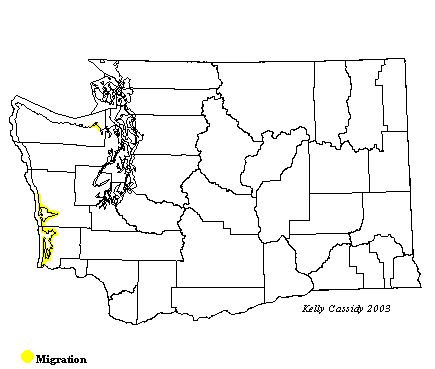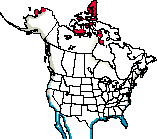Red Knot
General Description
The Red Knot is a sturdy, medium-sized shorebird with a short, straight bill and olive-yellow legs. In breeding plumage, it is bright rufous below and mottled gray and black above. The adult in non-breeding plumage is gray overall. The juvenile has white-tipped feathers on its wings, giving the wings a scalloped look.
Habitat
Red Knots breed in the far north, mostly above the Arctic Circle in both North America and Eurasia. Breeding grounds are often inland from the coast, and usually near a pond or stream. Red Knots migrate through and winter along shorelines around the world. Large sandy estuaries and tidal flats are most preferred.
Behavior
Red Knots form enormous flocks during migration and in winter. They are often found in flocks with Black-bellied Plovers and Short-billed Dowitchers. In the tundra, they feed by sight, picking food from the surface. On tidal flats, they probe for food with their bills--probing a few times and then running to a new spot.
Diet
On their breeding grounds, Red Knots eat insects (especially flies) as well as plant matter, especially early in the season before many insects are out. Small invertebrates including mollusks, crustaceans, and marine worms are part of the diet during migration and winter. Eastern populations eat numerous horseshoe crabs during migration.
Nesting
Males perform aerial displays high over the moist tundra and glacial till that are their nesting grounds. The nest is on the ground, usually near water. It is a shallow scrape lined with leaves, lichen, and moss. Both parents incubate the 3 to 4 eggs for 21 to 22 days. The young leave the nest shortly after hatching and feed themselves. The female departs shortly after the young hatch, leaving the male to tend the young for 18 to 20 days, until they can fly.
Migration Status
Red Knots winter on shorelines around the world. Many of the birds migrating through Washington are on their way to southern South America for the winter. These are late-spring migrants and are seldom seen before mid-April. They are usually present through May.
Conservation Status
The Canadian Wildlife Service estimates the global population at 1,290,000 birds, with 400,000 in North America. They were once more abundant in North America but were reduced by hunting in the late 1800s. Protection from hunting has led to some recovery, but the population has declined sharply for unknown reasons since the 1960s. Red Knots are currently listed on the Partners in Flight watch list. Over-harvesting of horseshoe crabs on the East Coast has resulted in the loss of a critical food supply during migration. Other threats to the population are the development of shorelines, limiting habitat, increased human disturbance, and oil spills along their migration routes and wintering range.
When and Where to Find in Washington
Red Knots migrate through Washington and are far more common in spring than fall. Some areas of Washington consistently have large flocks of Red Knots, while they are absent elsewhere. This patchy distribution is typical of the species. The largest flock is typically at Bottle Beach in Grays Harbor (Grays Harbor County). Other flocks are often seen around the perimeter of Willapa Bay and at Leadbetter Point. There are also usually flocks at Bowerman Basin in Grays Harbor. Spring migrants begin to arrive in mid- to late April. By late April, they are common, and then begin to taper off by the end of May. Red Knots are not common anywhere else on the Pacific Coast south of southern Alaska. Outside of these flocks, they are uncommon throughout coastal Washington in spring. In the fall, birds are seen in small numbers, but not in the huge flocks of the spring. They are found in western Washington from mid-August to mid-October, and there are rare reports in winter. Some birds, usually juveniles, also come through eastern Washington in the fall and have been sighted at the Walla Walla River delta (Walla Walla County) from early July to mid-October.
 Abundance
Abundance
| Ecoregion | Jan | Feb | Mar | Apr | May | Jun | Jul | Aug | Sep | Oct | Nov | Dec |
|---|---|---|---|---|---|---|---|---|---|---|---|---|
| Oceanic | ||||||||||||
| Pacific Northwest Coast | R | R | R | F | C | R | U | F | F | U | R | R |
| Puget Trough | R | R | R | R | ||||||||
| North Cascades | ||||||||||||
| West Cascades | ||||||||||||
| East Cascades | ||||||||||||
| Okanogan | ||||||||||||
| Canadian Rockies | ||||||||||||
| Blue Mountains | ||||||||||||
| Columbia Plateau |
Washington Range Map

North American Range Map


Family Members
 Spotted SandpiperActitis macularius
Spotted SandpiperActitis macularius Solitary SandpiperTringa solitaria
Solitary SandpiperTringa solitaria Gray-tailed TattlerTringa brevipes
Gray-tailed TattlerTringa brevipes Wandering TattlerTringa incana
Wandering TattlerTringa incana Greater YellowlegsTringa melanoleuca
Greater YellowlegsTringa melanoleuca WilletTringa semipalmata
WilletTringa semipalmata Lesser YellowlegsTringa flavipes
Lesser YellowlegsTringa flavipes Upland SandpiperBartramia longicauda
Upland SandpiperBartramia longicauda Little CurlewNumenius minutus
Little CurlewNumenius minutus WhimbrelNumenius phaeopus
WhimbrelNumenius phaeopus Bristle-thighed CurlewNumenius tahitiensis
Bristle-thighed CurlewNumenius tahitiensis Long-billed CurlewNumenius americanus
Long-billed CurlewNumenius americanus Hudsonian GodwitLimosa haemastica
Hudsonian GodwitLimosa haemastica Bar-tailed GodwitLimosa lapponica
Bar-tailed GodwitLimosa lapponica Marbled GodwitLimosa fedoa
Marbled GodwitLimosa fedoa Ruddy TurnstoneArenaria interpres
Ruddy TurnstoneArenaria interpres Black TurnstoneArenaria melanocephala
Black TurnstoneArenaria melanocephala SurfbirdAphriza virgata
SurfbirdAphriza virgata Great KnotCalidris tenuirostris
Great KnotCalidris tenuirostris Red KnotCalidris canutus
Red KnotCalidris canutus SanderlingCalidris alba
SanderlingCalidris alba Semipalmated SandpiperCalidris pusilla
Semipalmated SandpiperCalidris pusilla Western SandpiperCalidris mauri
Western SandpiperCalidris mauri Red-necked StintCalidris ruficollis
Red-necked StintCalidris ruficollis Little StintCalidris minuta
Little StintCalidris minuta Temminck's StintCalidris temminckii
Temminck's StintCalidris temminckii Least SandpiperCalidris minutilla
Least SandpiperCalidris minutilla White-rumped SandpiperCalidris fuscicollis
White-rumped SandpiperCalidris fuscicollis Baird's SandpiperCalidris bairdii
Baird's SandpiperCalidris bairdii Pectoral SandpiperCalidris melanotos
Pectoral SandpiperCalidris melanotos Sharp-tailed SandpiperCalidris acuminata
Sharp-tailed SandpiperCalidris acuminata Rock SandpiperCalidris ptilocnemis
Rock SandpiperCalidris ptilocnemis DunlinCalidris alpina
DunlinCalidris alpina Curlew SandpiperCalidris ferruginea
Curlew SandpiperCalidris ferruginea Stilt SandpiperCalidris himantopus
Stilt SandpiperCalidris himantopus Buff-breasted SandpiperTryngites subruficollis
Buff-breasted SandpiperTryngites subruficollis RuffPhilomachus pugnax
RuffPhilomachus pugnax Short-billed DowitcherLimnodromus griseus
Short-billed DowitcherLimnodromus griseus Long-billed DowitcherLimnodromus scolopaceus
Long-billed DowitcherLimnodromus scolopaceus Jack SnipeLymnocryptes minimus
Jack SnipeLymnocryptes minimus Wilson's SnipeGallinago delicata
Wilson's SnipeGallinago delicata Wilson's PhalaropePhalaropus tricolor
Wilson's PhalaropePhalaropus tricolor Red-necked PhalaropePhalaropus lobatus
Red-necked PhalaropePhalaropus lobatus Red PhalaropePhalaropus fulicarius
Red PhalaropePhalaropus fulicarius

